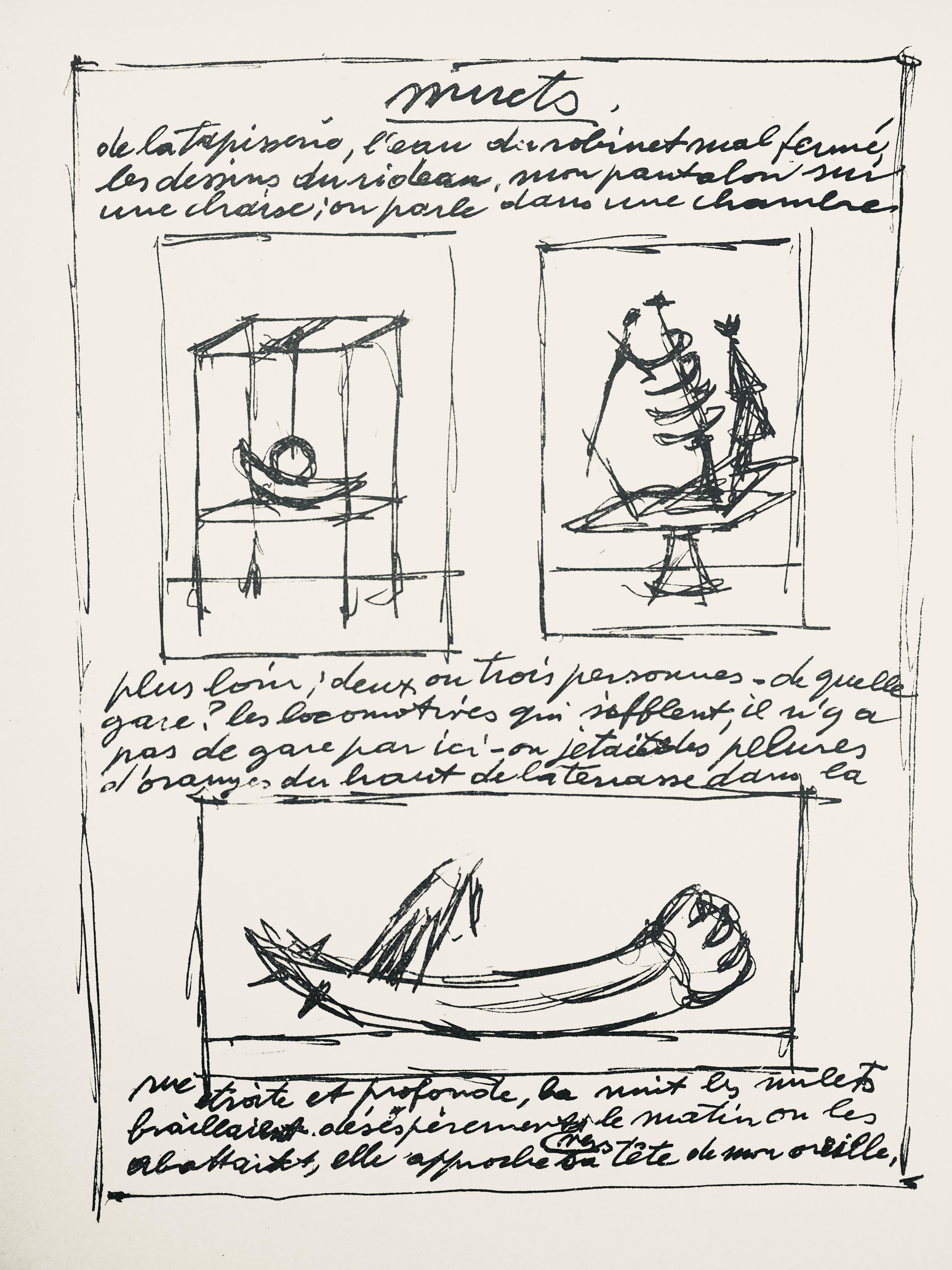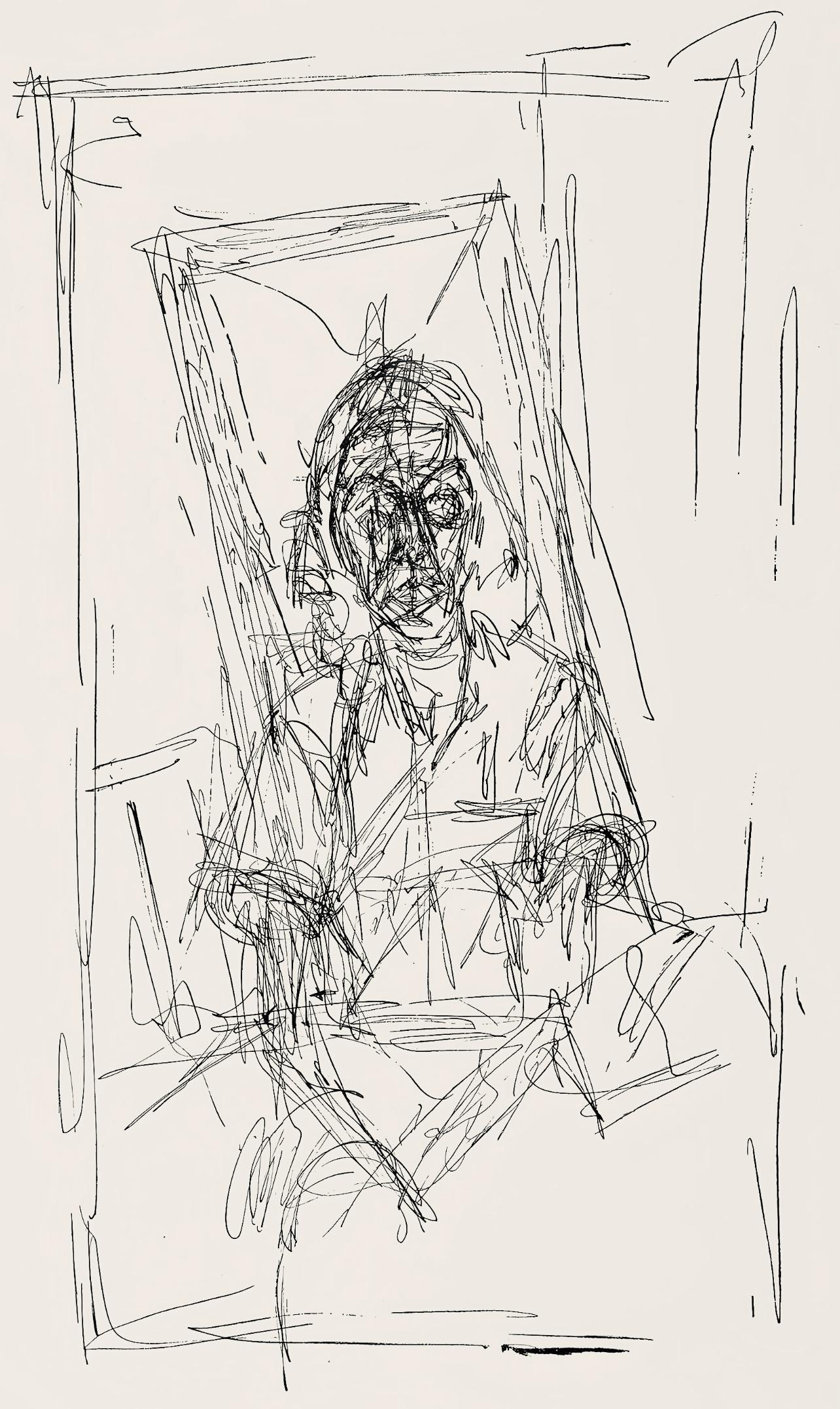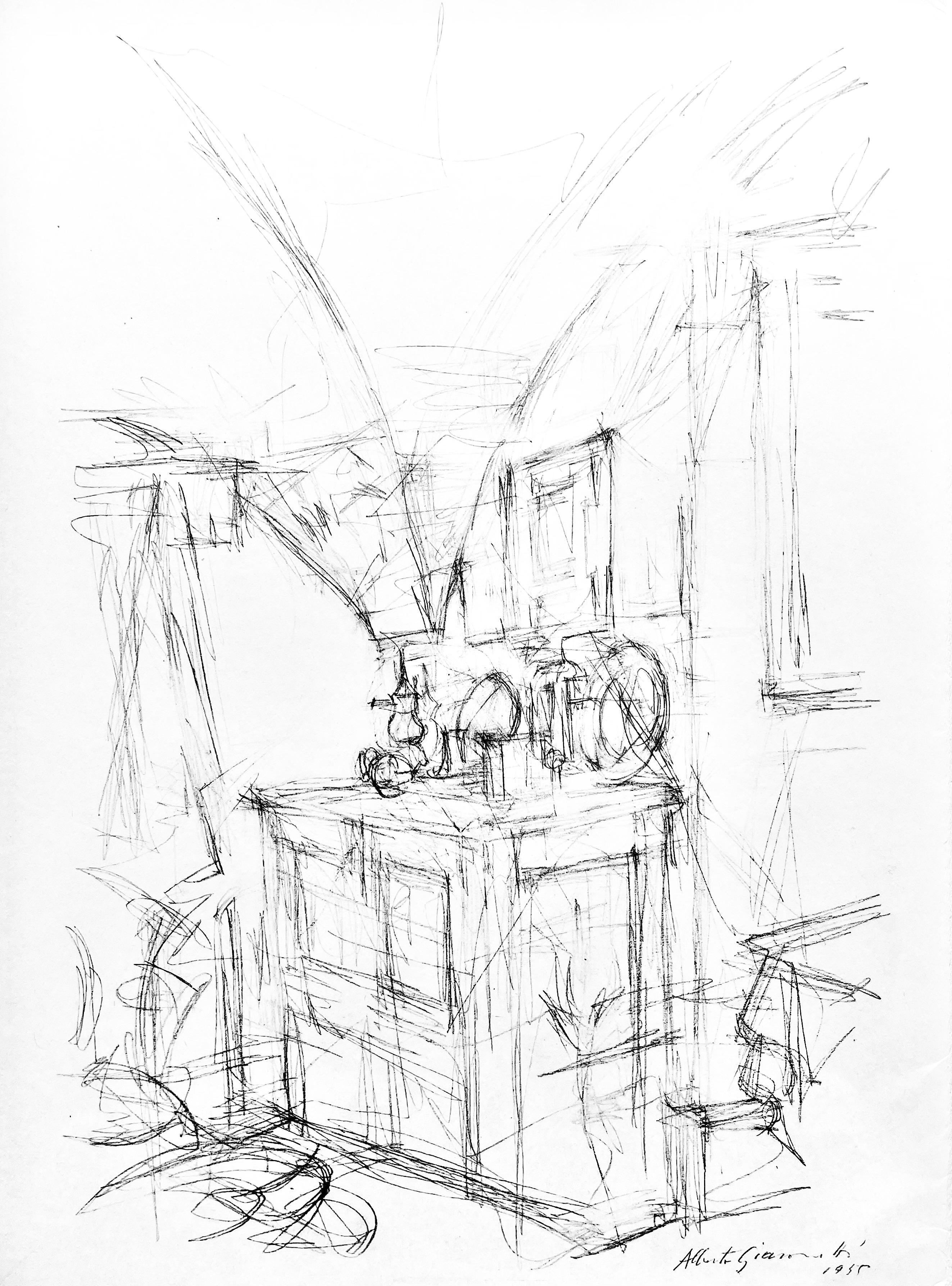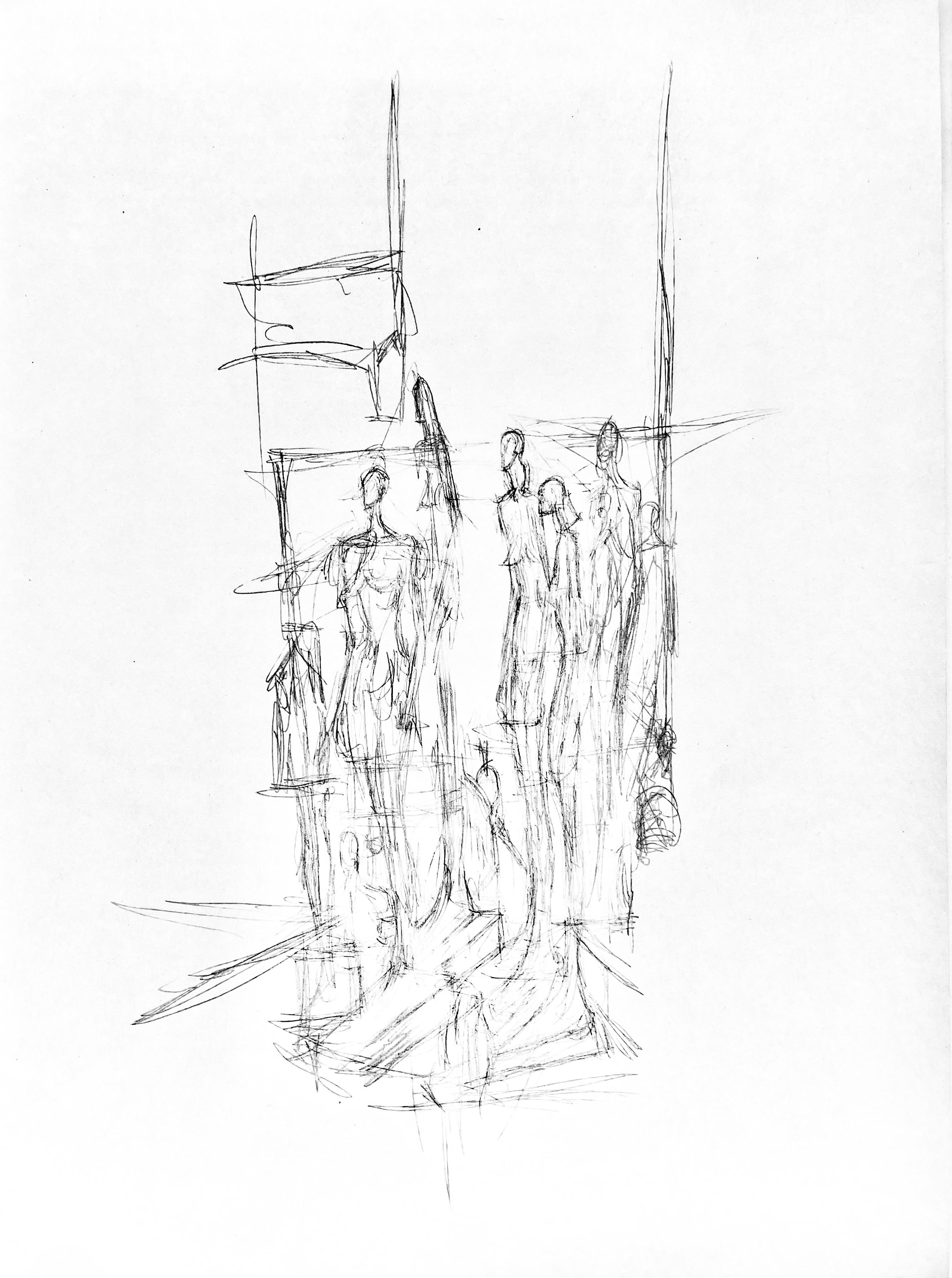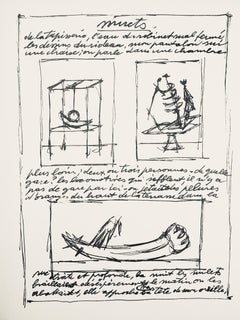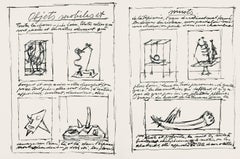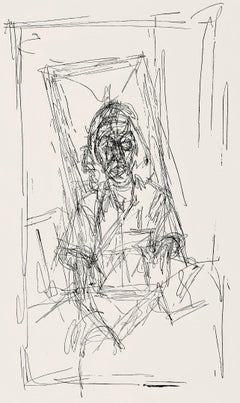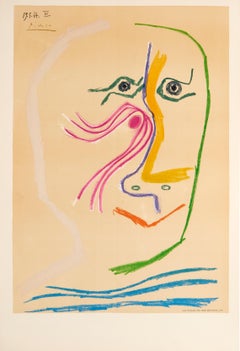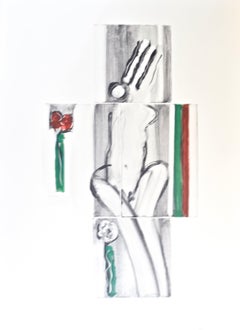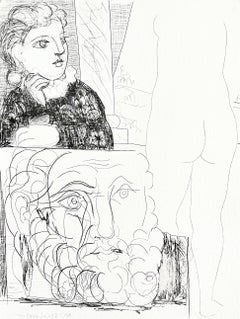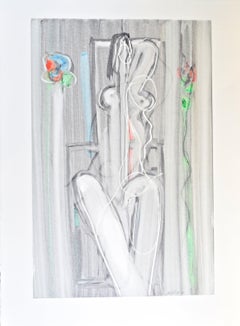Items Similar to Giacometti, Sans titre, Société internationale d'art XXe siècle (after)
Want more images or videos?
Request additional images or videos from the seller
1 of 5
Giacometti, Sans titre, Société internationale d'art XXe siècle (after)1952
1952
$1,196
$1,49520% Off
£927.06
£1,158.8320% Off
€1,054.43
€1,318.0420% Off
CA$1,714.05
CA$2,142.5620% Off
A$1,879.40
A$2,349.2520% Off
CHF 982.50
CHF 1,228.1220% Off
MX$22,509.48
MX$28,136.8420% Off
NOK 12,394.02
NOK 15,492.5320% Off
SEK 11,625.59
SEK 14,531.9920% Off
DKK 7,877.27
DKK 9,846.5820% Off
About the Item
Lithograph on vélin paper. Paper Size: 12.4 x 9.65 inches. Inscription: Unsigned and unnumbered, as issued. Notes: From the album, XXe siècle, Nouvelle série N°3 (double) Juin 1952, Cahiers d'Art publiés sous la direction de Gualtieri di San Lazzaro, Art et poésie depuis Apollinaire, 1952. Published by Société Internationale d'Art XXe siècle, Paris, under the direction of Gualtieri di San Lazzaro, éditeur, Paris; printed by Mourlot Frères, Paris, 1952. Additional notes: Excerpted from the academic article, “Promoting Original Prints, The Role of Gualtieri di San Lazzaro and XXe Siècle” by Valerie Holman, published in Print Quarterly, XXXIII, 2016, 2, Until recently very little has been written on the Italian author and art publisher Gualtieri di San Lazzaro (1904-75), yet for 50 years he chronicled the life and work of contemporary artists, produced monographs of exceptional quality, and disseminated original prints by modern painters and sculptors through his best-known periodical, XXe Siècle. Although still a relatively unfamiliar figure in the United Kingdom, San Lazzaro is one of the half-dozen great art publishers of the mid-twentieth century who, together with his exemplar, Ambroise Vollard (1866-1939), and those of his own generation, Christian Zervos (1889-1970), Tériade (1889-1983) and Albert Skira (1904-73), chose to base himself in Paris, seeing it throughout his life as the centre of the art world….XXe Siècle, an illustrated periodical, was launched in 1938 and printed in editions of approximately 2,000, each issue containing both photographs and four-colour separation reproductions across a wide spectrum of visual imagery ranging from masterpieces of Western painting to popular prints from the Far East. Its large format, lively design, and close integration of text and image, were immediately striking, but its most innovative feature, introduced at the suggestion of Hans Arp (1886-1966), was the inclusion of original prints by contemporary artists in every issue. With obvious appeal for collectors, XXe Siècle was also designed to introduce a wider, international public to contemporary painting and sculpture through good quality colour reproductions and the immediacy of original prints. Comparable in price to Cahiers d'Art, early issues of XXe Siècle sold out rapidly. While San Lazzaro's own aesthetic preferences tended towards lyric abstraction, he made clear that XXe Siècle was non-partisan [publication ceased during World War II]….in 1951, San Lazzaro relaunched XXe Siècle with thematic issues that were materials based, or centred on a topic of current interest in the visual arts, particularly in Europe: concepts of space, matter, monochrome, mark-making and the sign.' A defining feature of the new series was Italy's artistic dialogue with France for, while San Laz-zaro had originally concentrated on Paris-based painters and sculptors, his aim was to create an international network, to make known the work of French artists in Italy and Italian artists in France, and subsequently extend this bilateral axis to the English-speak-ing world. The artists represented in No. I by an original print were all best known as sculptors: Arp, Laurens, Henry Moore (1898-186) and Marino Marini, San Lazzaro not only sought to show readers the full range of an artist's work, but to encourage the production of prints, a stimulus much appreciated, for example, by Magnelli…. Suffering from failing health, in 1968 San Lazzaro lost overall control of XXe Siècle to Léon Amiel, a printer-publisher who had provided financial backing and helped with distribution in America." Thematic issues now ceased and were replaced by a 'panorama' of the year, but San Lazzaro was still active as a publisher of books and albums of prints….Shortly after his death, San Lazzaro himself was the subject of two exhibitions: 'Omaggio a XXe Siècle' in Milan in December 1974 centred on graphic work by those artists closest to him late in life, while 'San Laz-zaro et ses Amis' at the Musée d'Art Moderne de la Ville de Paris in 1975 featured work by all those whose work he had promoted for more than 50 years: Arp, Calder (1898-1976), Capogrossi, Chagall, Sonia Delau-nay, Dubuffet, Estève, Lucio Fontana (1899-1968), Gili-oli (1911-77), Magnelli, Marini, Miró, Moore and Poliakoff. This exhibition was seen by one of his closest colleagues as an indirect portrait of San Lazzaro, a complex man whose modesty and reserve masked his unremitting drive to extend international appreciation of contemporary art, and to bring the reading public closer to its making through the medium of print.
ALBERTO GIACOMETTI (1901-1966) was a Swiss sculptor, painter, draftsman and printmaker. Beginning in 1922, he lived and worked mainly in Paris but regularly visited his hometown Borgonovo to see his family and work on his art. In 1922, he moved to Paris to study under the sculptor Antoine Bourdelle, an associate of Rodin. It was there that Giacometti experimented with Cubism and Surrealism and came to be regarded as one of the leading Surrealist sculptors. Among his associates were Miró, Max Ernst, Picasso, Bror Hjorth, and Balthus. In May 2015, Giacometti's sculpture, "L'Homme au doigt" sold for $141.3 million USD at Christie's in New York, which set a world record for the artist, and setting the highest price to date ever garnered for a sculpture by any artist in history.
- Creation Year:1952
- Dimensions:Height: 12.4 in (31.5 cm)Width: 9.65 in (24.52 cm)
- Medium:
- Movement & Style:
- After:Alberto Giacometti (1901 - 1966, Swiss)
- Period:
- Condition:
- Gallery Location:Southampton, NY
- Reference Number:1stDibs: LU1465216461192
About the Seller
4.9
Platinum Seller
Premium sellers with a 4.7+ rating and 24-hour response times
Established in 1978
1stDibs seller since 2021
1,215 sales on 1stDibs
Typical response time: <1 hour
- ShippingRetrieving quote...Shipping from: Southampton, NY
- Return Policy
Authenticity Guarantee
In the unlikely event there’s an issue with an item’s authenticity, contact us within 1 year for a full refund. DetailsMoney-Back Guarantee
If your item is not as described, is damaged in transit, or does not arrive, contact us within 7 days for a full refund. Details24-Hour Cancellation
You have a 24-hour grace period in which to reconsider your purchase, with no questions asked.Vetted Professional Sellers
Our world-class sellers must adhere to strict standards for service and quality, maintaining the integrity of our listings.Price-Match Guarantee
If you find that a seller listed the same item for a lower price elsewhere, we’ll match it.Trusted Global Delivery
Our best-in-class carrier network provides specialized shipping options worldwide, including custom delivery.More From This Seller
View AllGiacometti, Sans titre, Société internationale d'art XXe siècle (after)
By Alberto Giacometti
Located in Southampton, NY
Lithograph on vélin paper. Paper Size: 12.4 x 9.65 inches. Inscription: Unsigned and unnumbered, as issued. Notes: From the album, XXe siècle, Nouvelle série N°3 (double) Juin 1952, ...
Category
1950s Modern Abstract Prints
Materials
Lithograph
$1,196 Sale Price
20% Off
Free Shipping
Giacometti, Sans titre, Société internationale d'art XXe siècle (after)
By Alberto Giacometti
Located in Southampton, NY
Lithograph on vélin paper. Paper Size: 12.4 x 19.3 inches, with centerfold and stitch perforations, as issued. Inscription: Unsigned and unnumbered, as issued. Notes: From the album,...
Category
1950s Modern Abstract Prints
Materials
Lithograph
$1,276 Sale Price
20% Off
Free Shipping
Giacometti, Sans titre, Société internationale d'art XXe siècle (after)
By Alberto Giacometti
Located in Southampton, NY
Lithograph on vélin paper. Paper Size: 12.4 x 9.65 inches. Inscription: Unsigned and unnumbered, as issued. Notes: From the album, XXe siècle, Nouvelle série N° 7 (double) Juin 1956,...
Category
1950s Modern Abstract Prints
Materials
Lithograph
$796 Sale Price
20% Off
Free Shipping
Alberto Giacometti, Nude in Profile, from Derriere le miroir, 1956 (after)
By Alberto Giacometti
Located in Southampton, NY
This exquisite etching after Alberto Giacometti (1901–1966), titled Nu de Profil (Nude in Profile), from the folio Derriere le miroir, 10 Ans d'Edition 1946-1956, No. 92-93, originates from the 1956 edition published by Maeght Editeur, Paris, and printed by Atelier Crommelynck, Paris, 1956. This work exemplifies Giacometti’s mastery of line and existential sensitivity, capturing the fragility, grace, and introspection that define his vision of the human form.
Executed as an etching, cuivre rayé apres tirage on velin paper, this work measures 15 x 11 inches overall; 12.2 x 2.17 inches image size. Unsigned and unnumbered as issued. The edition exemplifies the superb craftsmanship of Atelier Crommelynck, Paris.
Artwork Details:
Artist: After Alberto Giacometti (1901–1966)
Title: Nu de Profil (Nude in Profile), from the folio Derriere le miroir, 10 Ans d'Edition 1946-1956, No. 92-93
Medium: Etching, cuivre rayé apres tirage on velin paper
Dimensions: 15 x 11 inches, overall; 12.2 x 2.17 inches, image size (38.1 x 27.94 cm; 31 x 5.5 cm)
Inscription: Unsigned and unnumbered as issued
Date: 1956
Publisher: Maeght Editeur, Paris
Printer: Atelier Crommelynck, Paris
Condition: Well preserved, consistent with age and medium
Provenance: From the folio Derriere le miroir, 10 Ans d'Edition 1946-1956, No. 92-93, published by Maeght Editeur, Paris; printed by Atelier Crommelynck, Paris, 1956
Notes:
Excerpted from the folio (translated from French), This catalogue, forming a special issue of Derriere le miroir, was completed in October 1956 on the presses of Draeger Freres on behalf of Aime Maeght, Editeur. The original lithographs of Miro, Chagall and Bazaine were shot by Mourlot Freres. The eaux-fortes rayees of Miro and Giacometti were shot by Crommelynck. Raoul Ubac composed and pulled the engraved wood from the cover. The photographs of Braque's reproduced works are by Mr. Routhier. Those of the other artists of Y. Hervochon.
About the Publication:
Derriere le miroir (Behind the Mirror) was one of the most important art publications of the 20th century, created and published by Maeght Editeur in Paris from 1946 to 1982. Founded by the visionary art dealer and publisher Aime Maeght, the series served as both an exhibition catalogue and a work of art in its own right, uniting original lithographs by leading modern and contemporary artists with critical essays, poetry, and design of the highest quality. Printed by master lithographers such as Mourlot Freres and Arte, Derriere le miroir became synonymous with the artistic vanguard of postwar Europe. Each issue was devoted to a single artist or theme and published to accompany exhibitions at the Galerie Maeght in Paris, featuring works by Pablo Picasso, Henri Matisse, Georges Braque, Joan Miro, Marc Chagall, Alexander Calder, Fernand Leger, and Alberto Giacometti, among others. The publication reflected Maeght's belief that art should be both accessible and elevated—an ideal realized through its luxurious production values, meticulous printing, and collaboration with the greatest creative minds of its time.
About the Artist:
Alberto Giacometti (1901–1966) was a Swiss sculptor, painter, and draughtsman whose hauntingly elongated figures and existential vision redefined modern art and made him one of the most influential artists of the 20th century. Born in Borgonovo, Switzerland, into an artistic family—his father, Giovanni Giacometti, was a noted Post-Impressionist—he was immersed in art from an early age before studying in Geneva and moving to Paris in 1922, where he became part of the city’s avant-garde alongside Pablo Picasso, Alexander Calder, Salvador Dali, Joan Miro, Wassily Kandinsky, Marcel Duchamp, and Man Ray. In the 1920s and 1930s, Giacometti explored Cubism and Surrealism, creating symbolic and dreamlike sculptures such as Suspended Ball (1930–31) and The Palace at 4 A.M. (1932), which reflected the influence of Dali, Duchamp, and Man Ray. By the 1940s, he abandoned Surrealism to pursue a deeply personal exploration of the human condition, developing his iconic attenuated figures that embodied both fragility and resilience. His signature sculptures—L’Homme qui marche I (Walking Man I), Femme debout, and Le Chariot—expressed the isolation, endurance, and vulnerability of modern existence, echoing the existential philosophy of Jean-Paul Sartre and Simone de Beauvoir. Giacometti’s figures, stripped of mass yet monumental in spirit, symbolized humanity’s search for meaning in a postwar world, while his paintings and drawings—portraits of his brother Diego, his wife Annette, and his friends—captured the psychological depth of perception with trembling, repetitive lines that blurred the boundary between body and soul. His friendships with Picasso, Calder, Miro, and Kandinsky shaped his understanding of form, motion, and space, while his philosophical engagement with Duchamp and Man Ray deepened his inquiry into the nature of reality and perception. Working obsessively in his modest Montparnasse studio, Giacometti pursued art as an existential act—destroying and rebuilding his figures in an endless search for truth. His influence on postwar art was immense, shaping the work of Henry Moore, Francis Bacon, Louise Bourgeois, Lucian Freud, and later contemporary sculptors such as Antony Gormley and Anselm Kiefer. His aesthetic also resonated beyond sculpture, influencing fashion, photography, and architecture through his vision of form, isolation, and proportion. Giacometti’s work is represented in major museum collections including MoMA, the Tate Modern, and the Centre Pompidou, and continues to inspire artists, collectors, and thinkers worldwide. Standing alongside Pablo Picasso, Alexander Calder, Salvador Dali, Joan Miro, Wassily Kandinsky, Marcel Duchamp, and Man Ray, Giacometti remains a towering figure in modern art—a sculptor-philosopher who transformed the human form into a universal symbol of resilience and reflection. His highest auction record was achieved by L’Homme qui marche I (Walking Man I), which sold for 141.3 million USD at Sotheby’s, London, on February 3, 2010, reaffirming Alberto Giacometti’s enduring legacy as one of the most visionary, profound, and collectible artists in the history of modern art.
After Alberto Giacometti Nu de Profil 1956, Giacometti Derriere le miroir No. 92-93, Giacometti etching...
Category
1950s Modern Abstract Prints
Materials
Etching
$1,996 Sale Price
20% Off
Free Shipping
Alberto Giacometti, The Studio II, from Derriere le miroir, 1957 (after)
By Alberto Giacometti
Located in Southampton, NY
This exquisite lithograph after Alberto Giacometti (1901–1966), titled L'Atelier II (The Studio II), from the folio Derriere le miroir, No. 98, originates from the 1957 edition publi...
Category
1950s Modern Abstract Prints
Materials
Lithograph
$716 Sale Price
20% Off
Free Shipping
Alberto Giacometti, The Studio II, from Derriere le miroir, 1957 (after)
By Alberto Giacometti
Located in Southampton, NY
This exquisite lithograph after Alberto Giacometti (1901–1966), titled L'Atelier II (The Studio II), from the folio Derriere le miroir, No. 98, originates from the 1957 edition publi...
Category
1950s Modern Abstract Prints
Materials
Lithograph
$716 Sale Price
20% Off
Free Shipping
You May Also Like
Hommage a Rene Char after Pablo Picasso
By Pablo Picasso
Located in New York, NY
This colorful lithograph after Pablo Picasso was printed by the Atelier Mourlot in Paris in 1964 and is unsigned*. This image is taken from a drawing in pencil and colored chalk enti...
Category
1960s Modern Abstract Prints
Materials
Lithograph
$2,800 Sale Price
20% Off
Untitled
Located in Nuevo Leon, MX
Obra sobre papel
Category
Mid-20th Century Abstract Prints
$500
Picasso, La Bonne dans l'Atelier de Sculpture (after)
By Pablo Picasso
Located in Fairfield, CT
Artist: After Pablo Picasso (1881-1973)
Title: La Bonne dans l'Atelier de Sculpture (after Bloch 184)
Year: 1992
Medium: Reproduced from the original edition using the grain Autotype...
Category
1990s Cubist Nude Prints
Materials
Lithograph
$3,400 Sale Price
20% Off
Untitled
Located in Nuevo Leon, MX
Obra sobre papel
Category
Mid-20th Century Abstract Prints
$500
Untitled
Located in Nuevo Leon, MX
Obra sobre papel
Category
Mid-20th Century Abstract Prints
$500
Untitled
Located in Nuevo Leon, MX
Obra sobre papel
Category
Mid-20th Century Abstract Prints
$500
